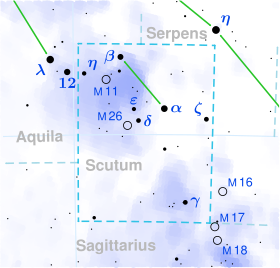Star in the constellation Scutum
β Scuti
Location of β Scuti (circled)
Observation dataEpoch J2000 Equinox J2000
Constellation
Scutum
Right ascension 18h 47m 10.474s [ 1]
Declination
−04° 44′ 52.342″[ 1]
Apparent magnitude (V)4.22[ 2]
Characteristics
Evolutionary stage
Giant star
Spectral type
G4IIa[ 3]
U−B color index
+0.84[ 4]
B−V color index
+1.09[ 4]
Astrometry Radial velocity (Rv )± 4.88[ 1] Proper motion (μ) RA: −7.972 mas /yr [ 1] Dec.: −16.398 mas /yr [ 1] Parallax (π)4.8549 ± 0.3403 mas [ 1] Distance 670 ± 50 ly pc )[ 1] Absolute magnitude (MV )−2.99[ 5] Orbit [ 6] Primary Beta Scuti A Companion Beta Scuti B Period (P)834 days Semi-major axis (a)2.8 mas Eccentricity (e)0.350 Inclination (i)105.9° Longitude of the node (Ω)288.1° Periastron epoch (T)2422480.9 Argument of periastron (ω)33.9° Details Radius +3.24 [ 7] R ☉ Luminosity ± 186[ 7] L ☉ Surface gravity (log g )0.94[ 8] cgs Temperature ± 25[ 7] K Metallicity -0.16[ 5] dex Rotational velocity (v sin i )7.8[ 9] Other designations β Sct,
BD -04°4582,
FK5 1489,
GC 25730,
GSC 05122-01426,
HIP 92175,
HR 7063,
HD 173764,
SAO 142618, CCDM 18472-0445
Database references SIMBAD data
Beta Scuti , Latinized from β Scuti, is a binary star system in the southern constellation Scutum . Based upon an annual parallax shift of 4.85 mas as seen from Earth,[ 1] light years from the Sun .
Characteristics
This is a spectroscopic binary with an orbital period of 2.3 years and eccentricity around 0.35.[ 10] [ 11]
The primary component has an apparent visual magnitude of +4.22 and is radiating about 1,315 times the luminosity of the Sun from its outer atmosphere at an effective temperature of 4,951 K.[ 7] G-type bright giant with a stellar classification of G4 IIa.[ 3] angular diameter was measured at 2.121 milliarcseconds by the Navy Precision Optical Interferometer , which gives it a physical radius of approximately 49 R ☉ at the estimated distance.[ 7]
The secondary was directly detected with a magnitude difference of 3.6 at a separation of about 17 milli-arcseconds using observations
from the Navy Precision Optical Interferometer.[ 12] Hubble Space Telescope which indicated a companion star was present were not definitive.[ 13] dynamical parallax .[ 14]
Beta Scuti was a latter designation of 6 Aquilae .[ 15]
References
^ a b c d e f g Vallenari, A.; et al. (Gaia collaboration) (2023). "Gaia Data Release 3. Summary of the content and survey properties" . Astronomy and Astrophysics . 674 : A1. arXiv :2208.00211 Bibcode :2023A&A...674A...1G . doi :10.1051/0004-6361/202243940 S2CID 244398875 . Gaia DR3 record for this source at VizieR .^ Mallik, Sushma V. (December 1999), "Lithium abundance and mass", Astronomy and Astrophysics , 352 : 495– 507, Bibcode :1999A&A...352..495M ^ a b Keenan, Philip C.; McNeil, Raymond C. (1989). "The Perkins catalog of revised MK types for the cooler stars". The Astrophysical Journal Supplement Series . 71 : 245. Bibcode :1989ApJS...71..245K . doi :10.1086/191373 . ^ a b Ducati, J. R. (2002). "VizieR Online Data Catalog: Catalogue of Stellar Photometry in Johnson's 11-color system". CDS/ADC Collection of Electronic Catalogues . 2237 . Bibcode :2002yCat.2237....0D . ^ a b Anderson, E.; Francis, Ch. (2012). "XHIP: An extended hipparcos compilation". Astronomy Letters . 38 (5): 331. arXiv :1108.4971 Bibcode :2012AstL...38..331A . doi :10.1134/S1063773712050015 . S2CID 119257644 . Vizier catalog entry ^ Ren, Shulin (2013). "Hipparcos Photocentric Orbits of 72 Single-lined Spectroscopic Binaries" . The Astronomical Journal . 145 (3): 81. Bibcode :2013AJ....145...81R . doi :10.1088/0004-6256/145/3/81 S2CID 120199240 . ^ a b c d e Baines, Ellyn K.; Clark, James H., III; Schmitt, Henrique R.; Stone, Jordan M.; von Braun, Kaspar (2023-12-01). "33 New Stellar Angular Diameters from the NPOI, and Nearly 180 NPOI Diameters as an Ensemble" . The Astronomical Journal . 166 (6): 268. Bibcode :2023AJ....166..268B . doi :10.3847/1538-3881/ad08be ISSN 0004-6256 . {{cite journal }}: CS1 maint: multiple names: authors list (link )^ Soubiran, Caroline; Le Campion, Jean-François; Brouillet, Nathalie; Chemin, Laurent (2016). "The PASTEL catalogue: 2016 version". Astronomy & Astrophysics . 591 : A118. arXiv :1605.07384 Bibcode :2016A&A...591A.118S . doi :10.1051/0004-6361/201628497 . S2CID 119258214 . ^ De Medeiros, J. R.; Mayor, M. (1999). "A catalog of rotational and radial velocities for evolved stars". Astronomy and Astrophysics Supplement Series . 139 (3): 433. arXiv :astro-ph/0608248 Bibcode :1999A&AS..139..433D . doi :10.1051/aas:1999401 . Vizier catalog entry ^ Pourbaix, D.; Tokovinin, A. A.; Batten, A. H.; Fekel, F. C.; Hartkopf, W. I.; Levato, H.; Morrell, N. I. ; Torres, G.; Udry, S. (2004). "SB9: The ninth catalogue of spectroscopic binary orbits". Astronomy and Astrophysics . 424 (2): 727– 732. arXiv :astro-ph/0406573 Bibcode :2004A&A...424..727P . doi :10.1051/0004-6361:20041213 . S2CID 119387088 . ^ Parsons, Sidney B.; Ake, Thomas B. (1998). "Ultraviolet and Optical Studies of Binaries with Luminous Cool Primaries and Hot Companions. V. The Entire IUE Sample" . The Astrophysical Journal Supplement Series . 119 (1): 83. Bibcode :1998ApJS..119...83P . doi :10.1086/313152 ^ Hutter, D. J.; Zavala, R. T.; Tycner, C.; Benson, J. A.; Hummel, C. A.; Sanborn, J.; Franz, O. G.; Johnston, K. J. (2016). "Surveying the Bright Stars by Optical Interferometry. I. A Search for Multiplicity among Stars of Spectral Types F-K" . Astrophysical Journal Supplement Series . 227 (1): 4. arXiv :1609.05254 Bibcode :2016ApJS..227....4H . doi :10.3847/0067-0049/227/1/4 S2CID 118803592 . ^ Parsons, S. B.; Franz, O. G.; Wassermann, L. H. (2005). "The Fine Guidance Sensor Orbit of the G4 Bright Giant HD 173764" . Astronomical Journal . 129 (3): 1700. Bibcode :2005AJ....129.1700P . doi :10.1086/427853 ^ Heintz, Wulff D. (1978). Double Stars - Springer . Vol. 15. Bibcode :1978GAM....15.....H . doi :10.1007/978-94-009-9836-0 . ISBN 978-90-277-0886-1 ^ Wagman, M. (August 1987). "Flamsteed's Missing Stars". Journal for the History of Astronomy . 18 (3): 212. Bibcode :1987JHA....18..209W . doi :10.1177/002182868701800305 . S2CID 118445625 .
